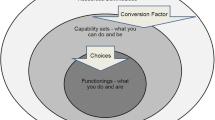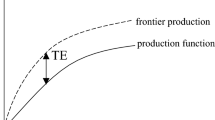Abstract
People with disability are particularly exposed to poor living conditions: on one hand they have more difficulties in getting an income cause to their inabilities, on the other hand conditions of poverty increase the risk of disability. However, little rigorous quantitative research has been undertaken to measure the real impact of disability on poverty. Methods based on monetary set (income and consumption) may not reflect the real possibility to convert resources into the fulfilment of personal goals. The capability approach, developed by A. K. Sen, offers a useful framework for the evaluation and assessment of individual well-being considering both monetary and non-monetary resources. The study describes a methodology, derived from the capability approach, to estimate the additional income needed for various types of household with and without disabled members to ensure the same satisfaction with economic resources. The method has been applied to the Italian contest, where 2.6 million people with disability live, and then the results are compared with the findings from an analogous study conducted in UK. The study reveals that disabled people in Italy need an income level two times higher to enjoy the same level of economic satisfaction, while in UK 50% of extra resource are sufficient. The findings suggests that traditional evaluations based on consumption lead to an underestimation of the needs of household containing disabled members. It follows that the financial benefits envisaged by actions planned by government through current instruments may not be completely effective.
Similar content being viewed by others
Notes
The Mental component score, calculated using a set of 12 specific queries to investigate the following aspects: interpersonal relationships, material wellbeing, personal development, physical wellbeing, self-determination, social inclusion, psychological wellbeing, rights.
Legislative Decree 109/1998 and subsequent amendments.
References
Baldassarre, G., Battisti, A., Minerba, L., Rosano, A., & Solipaca, A. (2006). La qualità della vita delle persone con disabilità. In Rapporto Osservasalute 2006 (pp. 182–184). Milano: Prex.
Birindelli, L. (2006). Retribuzioni, produttività e distribuzione del reddito in Italia. In L. Birindelli, G. D’Aloia & A. Megale (Eds.), Salari e contratti in Italia e in Europa. Rome: Ediesse.
Dubnoff, S., Vaughan, D., & Lancaster, C. (1981). Income satisfaction measures in equivalence scale applications. In Proceedings of the Social Statistics Section. Washington D.C.: American Statistical Association.
ISAE. (2004). Analisi del trattamento fiscale delle famiglie in Italia e prospettive di riforma. I Temi dei Rapporti dell’ISAE. Roma: ISAE
ISTAT. (2005). La povertà relativa in Italia nel 2004. Roma: Statistiche in breve, ISTAT.
ISTAT. Sistema di informazione statistica sulla disabilità. www.disabilitaincifre.it.
Kuklys, W. (2005). Amartya Sen’s capability approach. Theoretical insights and empirical applications. London: Springer.
Manski, C. (1999). Identification problems in the social sciences. Massachusetts: Harvard University Press.
Poulin, S. (1988). An application of analytic techniques to Canadian income satisfaction data. Ottawa: Statistics Canada, Labour and Household Surveys Analysis Division, Staff Reports.
Proto, G., & Solipaca, A. (2001). L’esperienza del matching tra le indagini multiscopo Salute e Banca d’Italia. MIMEO–ISTAT.
Sen, A. (1992). Inequality re-examined. Cambridge: Harvard University Press.
Sen, A. (1993). Capability and well-being. In M. C. Nussbaum, & A. Sen (Eds.), The quality of life . Oxford, Clarendon Press; Partial Italian translation, Capacità e benessere, in Id., Il tenore di vita. Tra benessere e libertà, Venezia, Marsilio, 1993, pp. 91–132.
Solipaca, A. (2007). Spesa mensile sostenuta dalle famiglie per l’assistenza a persone con disabili e anziani non autosufficienti. In Rapporto Osservasalute 2007 (pp. 192–193). Milano: Prex.
Van Praag, B. (1991). Ordinal and cardinal utility. An integration of the two dimensions of the welfare concept. Journal of Econometrics, 50, 69–89. doi:10.1016/0304-4076(91)90090-Z.
Vaughan, D. (1984). Using subjective assessments of income to estimate family equivalence scales: A report on work in progress. In Proceedings of the Social Statistics Section of the American Statistical Association.
Ware, J. E., Kosinski, M., & Keller, S. D. (1996). A 12-item short form health survey: Construction of scales and preliminary tests of reliability and validity. Medical Care, 34, 220–233. doi:10.1097/00005650-199603000-00003.
Author information
Authors and Affiliations
Corresponding author
Rights and permissions
About this article
Cite this article
Rosano, A., Mancini, F. & Solipaca, A. Poverty in People with Disabilities: Indicators from the Capability Approach. Soc Indic Res 94, 75–82 (2009). https://doi.org/10.1007/s11205-008-9337-1
Received:
Accepted:
Published:
Issue Date:
DOI: https://doi.org/10.1007/s11205-008-9337-1




